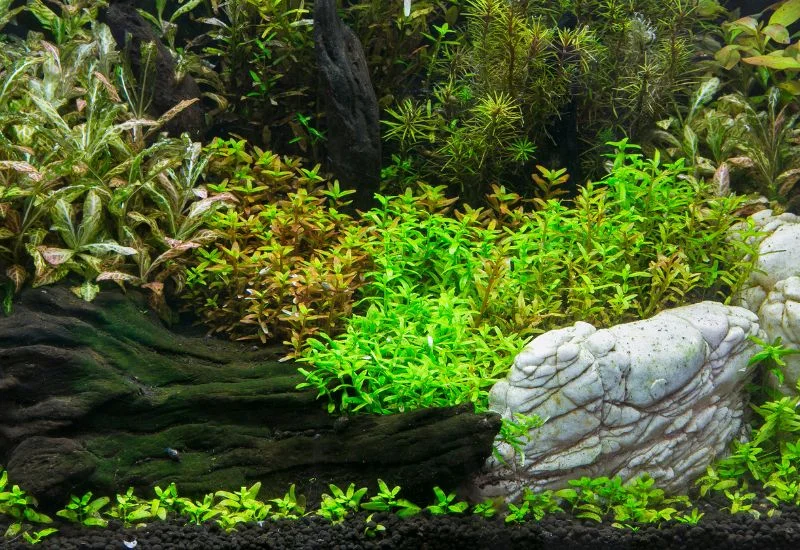Keeping plants healthy and brightly colored in an aquarium is a challenge that many aquarists face. Problems such as the formation of yellow leaves, slow growth, or the growth of more unwanted algae can be a problem.
Lack of adequate knowledge about caring for aquatic plants leads to many undesired outcomes. If no healthy plants are in your aquarium, the environment might appear less attractive and uninteresting, failing to produce a proper balance in the community.
The most fundamental factor of planted aquariums is the knowledge and understanding of the right type of plant, light, substrate, nutrients, and maintenance schedules.
By exploring this guide, you will understand how to choose the right plants, what conditions must be provided, and what to do for ultimate care.
Importance of Plants in the Aquarium
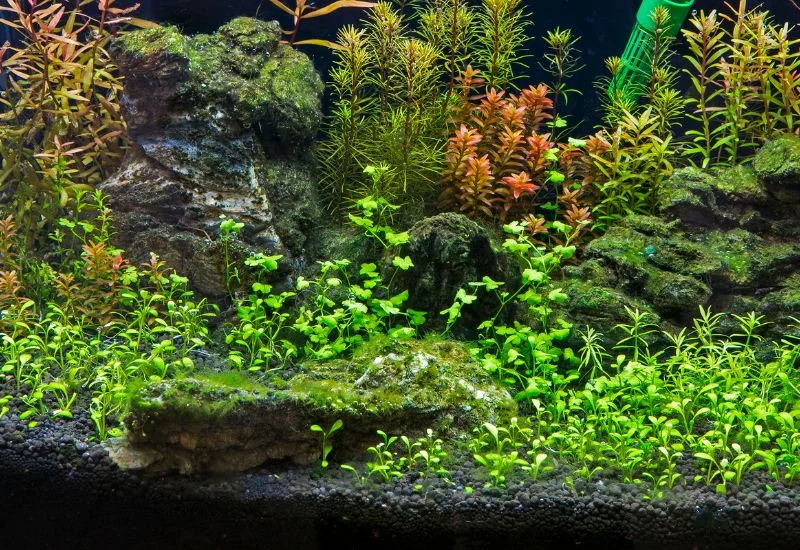
How are plants crucial in the aquarium space? Explore here:
Enhancing Oxygen Levels
Plants are essential in an aquarium because they are responsible for ensuring the proper supply of oxygen in the water. Plants can convert CO2 into oxygen through photosynthesis, which is very important to fish and other aquatic life.
When plants are grown well in a planted tank, cut down the need for artificial aeration in the aquarium.
Improving Water Quality
Plants help clean the water by filtering out materials such as ammonia, nitrites, and nitrates. This process purifies the water and ensures that it remains clean for a longer period. It also reduces the need for frequent changes, thus enhancing the health of the water habitat.
Providing Shelter and Breeding Grounds
Aquatic plants are very useful in providing shelter and habitat for fish and crustaceans. Plants like Java Moss and Hornwort enable the fry and some slow-swimming fish to hide in them due to their thick growth patterns.
Competing with Algae
There may be a few things as irritating as managing the quality of the algae in your fish tank. A healthy population of plants will fight algae for nutrients and space. A well-planted tank will show a low instance of algae as plants compete with algae for attached nutrients.1
Aesthetic Appeal
Apart from their usage, aquarium plants improve the aesthetic value of your tank. They offer the space more character, as well as emotion, which makes it simply better and easier to be in this particular space. Aquariums are beautiful items that can be a focus of any room and bring an atmosphere of calmness.
Species of Plants for the Aquarium
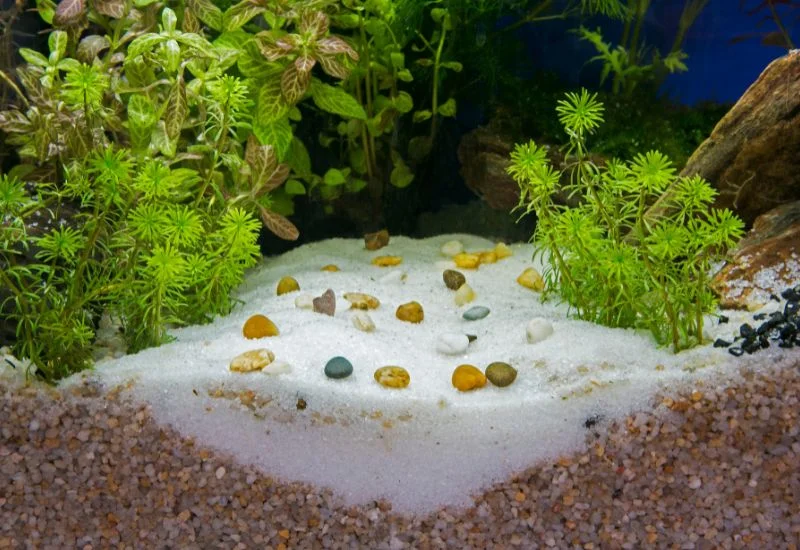
All the species of plants are not feasible to grow inside the aquarium. This is because the plants inside the aquarium are very specified. It is also important to select the plants that meet the environmental conditions of the fish.
A few major and preferred species for aquarium planting are;
Foreground Plants
The plants that are hunted for the ‘foreground’ are generally low-lying species in terms of height and develop in a way that they cover the ground area.
These plants are best suited for providing a carpet-like ground cover for your aquarium. Popular choices include:
Dwarf Hairgrass (Eleocharis parvula): A very quickly growing plant that forms a sward.
Java Moss (Taxiphyllum Barbieri): A versatile plant that can be used to spread out over the bottom or be anchored on pieces of driftwood and rocks.
Midground Plants
Midground plants are often large-medium-sized plants that are arranged in the middle of the tank. Such plants assist in creating a transition between the foreground and the background. Examples include:
Anubias (Anubias barteri): Slow-growing plant with large leaves that is ideal for sticking using the method of anchoring on rock or wood.
Cryptocoryne (Cryptocoryne wendtii): A perennial that is very tough, available in several shades of color, and can grow in low to slightly bright conditions.
Background Plants
These are higher plants that are placed at the back of an aquarium.
They are useful in establishing a curtain of foliage through which accessories like filters and heaters can easily be concealed.
They also make the aquarium more colorful and also give it an impression of depth. Common background plants include:
Amazon Sword (Echinodorus amazonicus): A leafy plant that can reach a height of 20 inches – this plant is rather large, so it stands out in an aquarium.
Vallisneria (Vallisneria spiralis): Having narrow, elongated leaves, this plant may create a ‘curtain-like’ effect on its background.
Floating Plants

These plants float on the water’s surface, and they cover most of the surface area, hence limiting the penetration of light to the deeper parts of the aquarium.
These plants are suitable for fish that dwell in a dark environment and prevent the abundant algae from overtaking the aquarium. Popular floating plants include:
Duckweed (Lemna minor): A small, fast-growing plant that covers the surface quickly.
Water Lettuce (Pistia stratiotes): A larger floating plant with rosette-shaped leaves that can provide shelter for fish.
Lighting Requirements for the Aquarium Plants
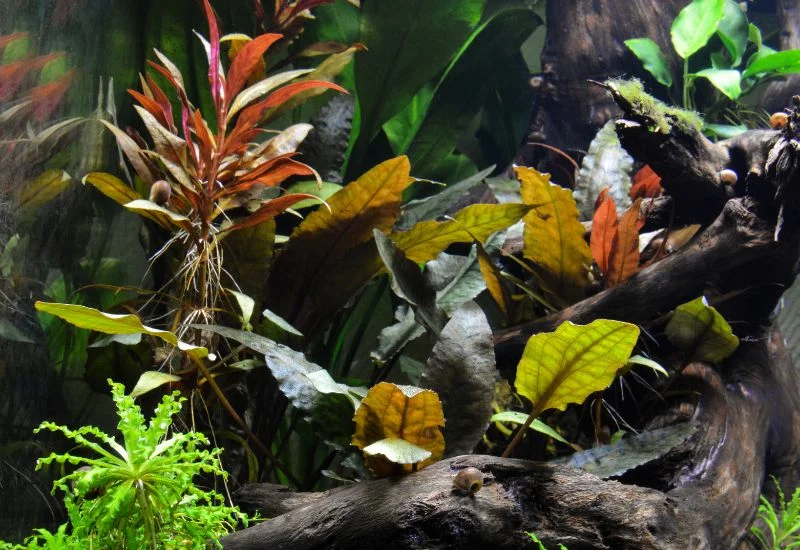
Light is essential in the process of photosynthesis, which is the process of producing energy in plants. The light that is being provided determines the growth and the health of the plants within an aquarium tank.
Understanding indoor lighting requirements for the different species enables you to grow healthy plants in the fish tank.
Low Light Plants
If you are a beginner or setting up a low-tech aquarium, low-light plants are recommended. Low-light plants do great in areas of the aquarium that have low-light exposure. Examples include:
Anubias (Anubias barteri): It prefers indirect sunlight, and it is conveniently simple to grow, which is ideal for a beginner.
Java Fern (Microsorum pteropus): A perennial that does not need to have high light intensity to grow.
Medium Light Plants
Plants that adapt to medium light conditions need slightly more attention, but any aquarist can easily maintain them. Examples include:
Cryptocoryne (Cryptocoryne wendtii): This is most adapted to partial shade and is known to have a vast number of colors and types of leaves.
Amazon Sword (Echinodorus amazonicus): Requires slightly bright light to preserve its dense foliage look.
High Light Plants
High-light plants require a lot of light and are commonly used in high-tech planted aquariums. Such plants may need top-ups of CO2 supplements and prudence to avoid encouraging the growth of the algae. Examples include:
Dwarf Baby Tears (Hemianthus callitrichoides): It is a favorite carpeting plant that needs high light and CO2 for its good growth.
Rotala (Rotala rotundifolia): This is especially noted for its change of color to brilliant red at strongly illuminated parts.
Substrate for the Plants
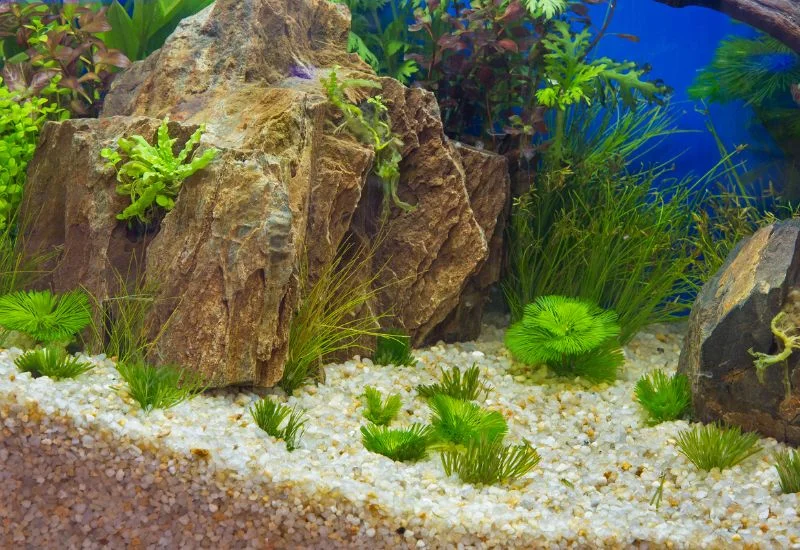
The bottom of your aquarium, and most aquatic plants fix their roots on it. This means that the proper selection of substrate can produce positive or negative effects on plant growth. It is a source of nutrients and the place where roots develop.
Substrate Types
Following are the substrate types that can be used for healthy aquarium planting;
Inert Substrates
The inert substrates do not provide nutrients. They give structural support to the plants. Gravel and sand are common inert substrates.
Gravel: Gravel comes in different sizes and colors, and they are easy to wash. It helps to penetrate water in the roots of the plant well. However, it may not be suitable for providing nutrients for all growing plants.
Sand: Sand is more attractive than gravel and preferred. It also does not contain certain elements that are required for proper growth, so root tabs have to be used.
Nutrient-Rich Substrates
These substrates consist of macronutrients such as nitrogen, phosphorus, and potassium that are slowly released to the plants. The nutrient-risch substrates that are recommended for planted aquariums include the Aqua Soil and Fluval Stratum2.
Aqua Soil: One of the most recommended by aquascapes, it has eich composition and stability in terms of pH.
Fluval Stratum: It has good moisture control and provides healthy root development, responding to almost any aquatic plant’s needs for minerals.
Layered Substrates
Substrate layering involves using a number of different materials which are best for plant growth. Generally, there is the nutrient layer upon which an infertile layer such as gravel or sand is applied.
This setup lets the plants obtain the nutrients and effectively stop the substrate from packing down.
Base Layer: The nutrient substrate serves as the platform or soil for the root to grow and get its nutrients.
Top Layer: They will include some gravel or sand that provides the mattress while also giving the aquarium a natural look.
Nutrients for the Aquatic Plants
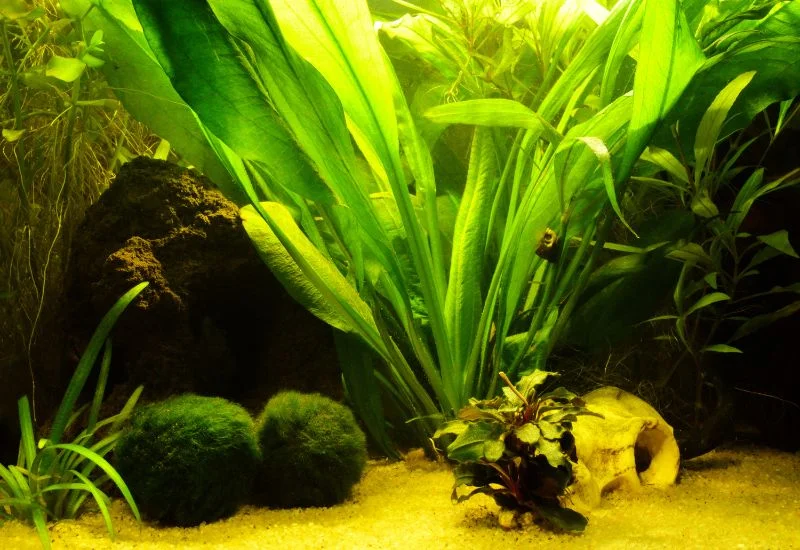
Nutrients are a key element for the survival of any living organism. Here is a guide to essential nutrients for aquatic plants3:
Essential Macronutrients
Macronutrients represent the major nutrients needed in larger quantities. The key macronutrients for aquatic plants are:
Nitrogen (N): Extremely important for the synthesis of proteins, nitrogen is taken up in the form of nitrates (NO3-). It is commonly obtained from fish waste and such decomposing materials in the natural water bodies.
Phosphorus (P): A component of ATP, nucleic acids, phospholipids and essential for root development and energy transport. Beneficial in enhancement of root system and flowering in some aquatic plants.
Potassium (K): These include a function in photosynthesis, enzyme activation, and disease, all of which are crucial to plant health. This is mostly incorporated through water-soluble slow-release fertilizers and root tabs.
Crucial Micronutrients
These are nutrients that a plant requires in small quantities but are very vital to the plant’s health. These include:
Iron (Fe): It plays an important role in chlorophyll synthesis, and when the plant lacks it, the leaves turn yellow (chlorosis). It is usually applied in solutions in the form of liquid fertilizers.
Magnesium (Mg): Magnesium is an element that is required for photosynthesis, and magnesium is needed by the plant as a component of chlorophyll.
Calcium (Ca): A very vital component that plays a significant role in cell wall construction and growth, its shortage leads to reduced or localized growth and distortion of the cell wall.
Carbon Dioxide (CO2): A balanced carbon dioxide level is important for the maintained growth of aquarium inhabitants.
Balancing Nutrients: Deficiency or excess of the nutrients may be fetal. So, its maintenance is crucial.
Aquatic Fertilizing Schedule
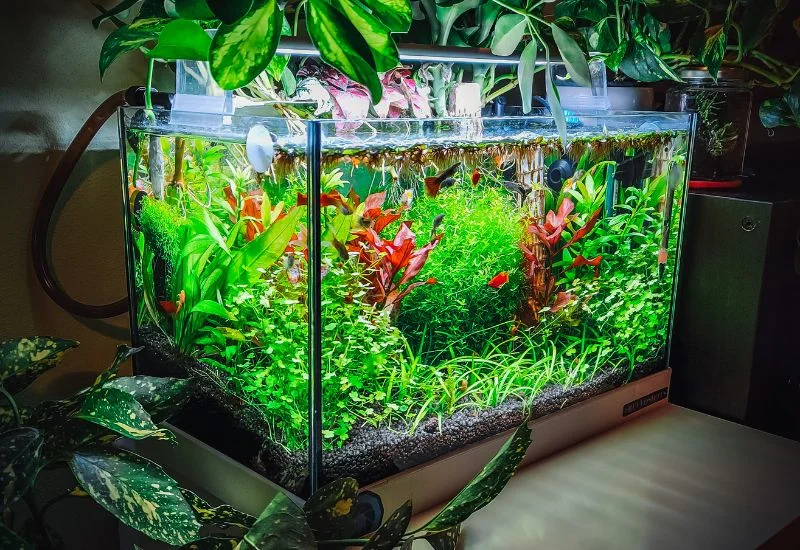
Fertilizing also has to be precise and efficient in supplying the needed nutrients to the plants without stressing the ecosystem of the aquarium.
Establishing a Routine
Fertilization of aquatic plants should be regular in order to ensure good growth and health.
Weekly Liquid Fertilizers: Liquid fertilizers are among the best inputs used in the supply of both macro and micronutrients to plants. These fertilizers are usually applied in the water column on a weekly basis.
General Fertilizers: To give a general supplement, products like Seachem Flourish and Tropica Plant Growth are advised as they always contain all the necessary nutrients.
Targeted Dosing: Individual nutrients to the fish tank like, iron, nitrogen or potassium are given according to the standard dose for the betterment.
Root Tabs
Root tabs are hard-scaped materials that are advanced into the soil, which then gradually discharge nutrients to the roots of plants. It is especially good for root-fed species, Amazon Swords, and Cryptocorynes, among them.
Placement: It is advisable to refill the root tabs in the pots about every three months or at the rate of growth of the plants.
Renewal: Root tabs being used are consumed in the process of plant growth; therefore, constant restocking is required to replenish the depleted stocks.
CO2 Supplementation
In large light and strong plants’ requirements, the use of CO2 significantly enhances the growth and life of the plants in the tanks. CO2 can be added through a range of methods, such as Pressure systems, CO2 reactors, and DIY methods.
CO2 Injection: Controlling factors such as the concentration of carbon dioxide can be managed by computerized systems, thus maintaining the best environment for photosynthesis.
Monitoring Levels: It is required to keep the CO2 parameters optimal for plant growth, which is 20-30 (Parts per million); this can be done using a CO2 drop checker or pH controller.
Some Common Plants of Aquarium
Here is a list of some of the most common plants that are found in every aquarium;
Java Fern
It is a low-light plant that has a hard texture and is attached to rocks or wood. It is used in the beneath layer of the aquarium. It is a classic choice for the aquarium owners.
Anubias
It is a genus of aquatic and semi-aquatic plants. It is also in the low-light to midlight range. So, Anubias is most suitable for the mid-layers in the Aquarius. Its adaptability to light variations makes it the preferred plant of the aquarium.
Hornwort
Hornwort is a medium-light aquatic plant. It grows well to produce green, splashy leaves. Its growing nature provides a habitat for the fishes to hide. So, it creates the upper layer of aquarium planting.
Red Ludwigia
Red Ludwigia is one of the most favorite plants in aquarium planting. Its attractive red coloration makes it more catchy and an attractive item in the home masterpiece (aquarium).
Useful Care Tips for the Aquatic Plants
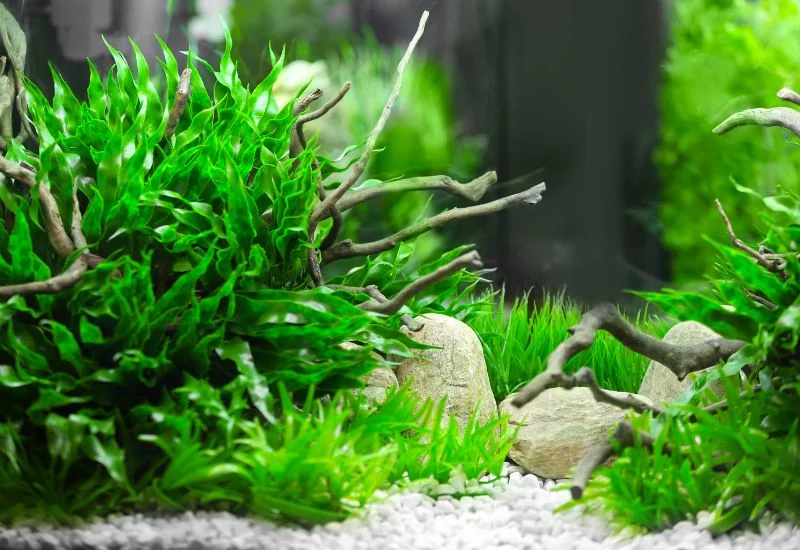
As you explored specific care and maintenance guides on the aquarium planting. Now, in this section, the general tips for aquarium plant care are described for your ease and healthy aquarium maintenance;
Regular Testing
Regular testing and checking in any aspect is a key to being at a safe end. If you are proactive, it will be easy to find the problems on time before they become severe and damaging. So, check your aquarium and plants daily for any exceptions. If you notice any unwanted changes, then try to understand the issue and its solution.
Water Changing
Water is a major part of the aquarium. Water provides the medium of survival in both of your aquariums: plants and fish. Visual testing of water gives an overview of the insoluble materials in water and dirtiness.
After that, also check the water level, pH, toxicity, and nutrients as per standards for your aquarium.
Algae Control
Due to the sustained water, your aquarium is a favorite place for algal growth. If you don’t care about the cleanliness of your aquarium, the growth of algae will be dominant in the tank. Check water quality daily remove unwanted insoluble particles, and avoid waterlogging.
Regular Pruning
A balance between both populations in an aquarium is essential. So, it is necessary to keep the growth and extensions of aquarium plants controlled. For this, regular cutting and pruning of the plants is required.
CO2 Levels
A significant carbon dioxide level is essential not only for the proper growth of the plants but also for the fish. An increased CO2 level leads to suffocation in fish, and a low level may lead to stunted growth in plants.
Reverse Osmosis Filtration (Optional)
Reverse osmosis filtration ensures high quality and maintained water composition. It can be an addition to your aquarium for the premium quality of plants and species.
Conclusion
The presence of the plants in the aquarium is not just an aesthetic appearance but also provides a natural-like environment for the survival and growth of fish. However, very specified care measures are required to maintain both lives in an artificial culture.
In this comprehensive guide, you’ve learned all the basics of aquatic plants, which will help you manage your aquarium efficiently next time.
Frequently Asked Questions
Article Sources
Oceanexist provides reliable information with good-quality references to support the facts.
